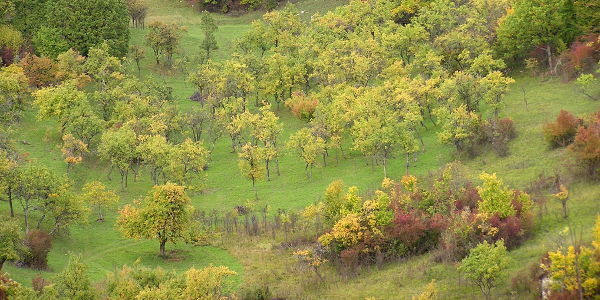Traditional Orchards in Hungary
Traditional orchards in Hungary are places, where we find different species of fruit-trees of different ages and varieties, where trees are planted in less regular rows, and where extensive cultivation takes place.
They can be gardens, orchards within vineyards, fruit-trees on pastures, in cemeteries, fruit-alleys along the roadside, bordering arable land etc.; along the rivers, inside the dykes, there are also flood plain-orchards.
In these orchards plums are the most common but beside it there are also numerous apple-, pea-r, cherry-, nuttrees, etc. Varieties in these orchards are mainly local (e.g. Sóvári, Batul apple) and ancient sorts. Traditional varieties were abundantly grown until the end of 19th century.
Traditional orchards lost their economic value
Traditional orchards were cultivated without any chemicals. They were mown or grazed.
In the 1920s, traditional orchards have significantly lost their economic value, because fruit growing became more intensive with new varieties and technologies. Later, the economic interest in the fruit market was almost completely lost and thus the preservation of fruit trees was discontinued.
Over the past 50 years, a considerable part of all orchards – with the exception of house gardens - were abandoned. Old trees were cut or burned and the gardens became overgrown with scrub.
Some of them are used as a holiday-resort, or weekend-garden, where the owners protected the old fruit-trees, but a lot were abandoned and left to renaturalisation.
Preserving by NGOs and national parks
Most traditional orchards in Hungary are neglected and in bad condition. The area beneath the trees is not cultivated, the trees are old. Their utilisation as tourist places is not solved, fruit serves the inhabitant's needs only.
NGOs and national parks play an important role in preserving traditional orchards. They monitor and clean up orchards, unveil endangered cultivars and launch study pathways.
Our department went on excursions to explore old cultivars (mainly apples) in neighbouring countries in the Sub-Carpathian region. In Ukraine (near Visk) the trees often reach the age of 100 years. The spacing is wide, orchards are used as meadows or grazing grounds. For financial reasons, spraying is not applied, thus crops are organic. In Transylvania, old cultivars are mainly found in home gardens and local people maintain enormous knowledge about them.








